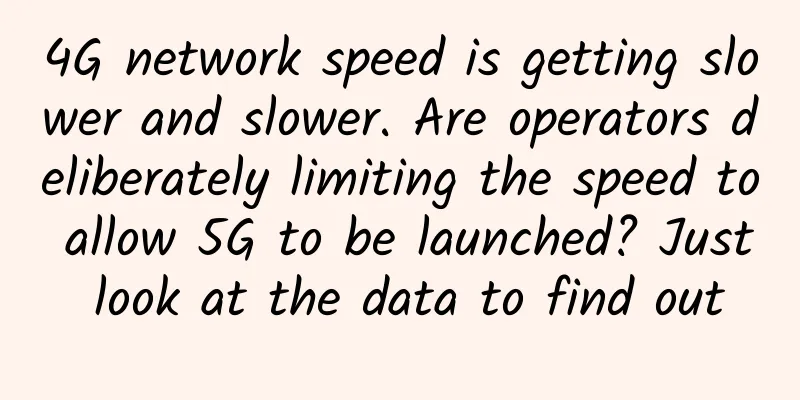4G network speed is getting slower and slower. Are operators deliberately limiting the speed to allow 5G to be launched? Just look at the data to find out

|
Let's first look at a set of data. Since 2018, the monthly mobile data traffic per person has increased from the original 4G per month to today's 14G per month. Especially in the two years since the opening of 5G, the average mobile data traffic per person has doubled. The latest data in October 2021 is an average of 14.32G per person per month. So the question is, how many GB of traffic do you use on average per month now? Please leave your usage in the comment area. This is a new technology classroom full of love and curiosity about technology. If you are like me, please follow me and explore the stories behind technology and new technological knowledge with me. If you are interested in today's video, please like it before watching it. Since the launch of 5G, operators have used various methods to get users to activate 5G packages. However, since 5G base stations are still not perfect, some people turned off 5G and found that the speed became slower when using 4G. So they began to blame the operators for forcing users to use 5G packages and that 5G base stations have not been built, resulting in slow 4G/5G speeds. In fact, this debate has never stopped since 5G was commercialized. I have personally encountered a similar situation. I turned off 5G and found that even an ordinary video played on 4G was stuck. Later, I consulted friends from the operator and checked some data. I found that things are not as simple as we thought. Why do I say that? Let me express my personal opinion on the change of 4G speed. First of all, I declare that I am standing from an objective perspective and using data analysis. 1. User demand for Internet access increases, and 4G bandwidth capacity reaches its limitWhy do we say that? Let's analyze the chart at the beginning of the video. Since the popularization of 4G, the average monthly traffic per capita in 2015 was only 380 megabytes. In that era, traffic was very expensive. I remember that it cost about 50 yuan to buy 1G of traffic outside the package, so many people used wireless networks to surf the Internet. By October 2021, the average traffic per capita reached 14.32G, and the average demand for Internet traffic per capita increased by nearly 40 times. Although 4G base stations are under construction every year, 4G network technology has its own limitations, just like the routers we use at home. In the past, the three mobile phones at home had very fast Internet access speeds, but now the broadband has been upgraded to 300M, and the speed has slowed down. The reason is that the number of smart devices at home has increased, such as TVs, refrigerators, air conditioners, smart phones, sweeping robots, etc. As long as they are connected to the router, they will occupy the bandwidth capacity of the router. If you want fast speed, you must switch to a WIFI6 router. 4G also has such problems, which is why the country has accelerated the promotion and construction of 5G in the past two years. my country's mobile Internet ranks first in the world in terms of both the number of users and traffic usage, because we have a large number of existing users, and 5G must be built. Then someone may ask, since 5G is so expensive, isn’t it more cost-effective to increase the channel capacity of 4G? 2. Channel capacity is constrained by channel bandwidth and signal powerBandwidth and signal power have a restrictive relationship with capacity, which we can derive using Shannon's formula as a theory. C represents channel capacity, B represents channel bandwidth, S represents average signal power, and N represents average noise power. From Shannon's formula, we can see that if we want to increase the channel capacity, the first thing is to increase the channel width, that is, the channel bandwidth, and the second is to increase the signal-to-noise ratio S/N; 4G technology limits the spectrum width of the signal. If you want to increase the spectrum width, the technology must change, such as 5G, or increase the maximum spectrum width of 4G. However, the higher the spectrum, the greater the signal attenuation during the transmission process, so the distance between base stations is reduced. Obviously, this method is not feasible. What remains is to improve the signal-to-noise ratio, that is, to increase the signal power. If the signal power is to be increased, the components of the entire 4G base station must be replaced with more sophisticated and costly components, and the power supply power of the base station must also be increased. From the perspective of increasing the power of the base station alone, the equipment that needs to be replaced is not as simple as a radio frequency component, and from a cost perspective, replacing so many components is not as good as upgrading directly to 5G. So the answer is obvious. It is not feasible to increase the bandwidth of 4G base stations. Whether analyzing from the above perspective of the increasing demand for mobile data traffic with the development of mobile Internet, or analyzing from the perspective of 4G bandwidth capacity technology, the slowdown of 4G speed is because the 4G bandwidth capacity has reached its limit as the amount of user data has surged. It is not that the operators deliberately slow down the 4G speed in order to get you to activate 5G. Even if the operators dare to do so, in this information age, complaints and public opinion will not allow them to do so. As users, we should view this matter from the perspective of the laws of development. When you were a child, you thought the roads in your rural hometown were already very wide. When you go back to your hometown after living in the city for a few years, do you think the roads that you thought were very wide before are still as wide now? |
<<: Meta and Microsoft integrate Workplace and Teams to provide new features
>>: Created a debuggable gRPC GUI client
Recommend
HostKvm Spring Special Offer: $48/year KVM-4G/40GB/1TB/Hong Kong Data Center
After the Chinese New Year, HostKvm sent a specia...
Two ways 5G will change cloud computing
5G is coming, and most people are looking for the...
HostHatch: 2TB hard drive VPS annual payment of $50, 8G memory VPS annual payment from $35
HostHatch is a foreign hosting company founded in...
IDC survey: Only 9% of enterprises plan to use 5G for IoT deployment
5G promises to be ten times faster than existing ...
How do operators grasp the pulse of the cloud computing market in the 5G era?
On June 6, 2019, the Ministry of Industry and Inf...
China Academy of Information and Communications Technology: In November, domestic 5G mobile phone shipments reached 20.136 million units, accounting for 68.1%
On December 10, the China Academy of Information ...
In-depth interpretation of the principles and applications of HTTP/3
HTTP3 is the latest version of the HTTP protocol....
Research on 5G promoting industrial information transformation and upgrading
Three years after 5G was put into commercial use,...
H.266 codec standard released to replace H.265/HEVC: video clarity remains unchanged, data volume is halved
This week, Fraunhofer HHI officially announced th...
Tencent Cloud 618 Procurement Season, 2C4G6M lightweight server starts at 128 yuan/year, 2C2G4M starts at 18 yuan for three months
We participated in the preheating and received co...
AkkoCloud: San Jose CN2 GIA/Germany CN2 GIA, starting at 299 yuan per year, 300-500Mbps bandwidth
AkkoCloud is a Chinese hosting company founded in...
360 Wang Yangdong: IOT devices require all-round security protection, and every detail cannot be ignored
[51CTO.com original article] On December 1-2, 201...
5G is not about mobile phones, but about the Internet of Things.
[[321085]] Recently, new infrastructure has conti...
The story behind 2.5 million 5G users in 5 months
[[275646]] South Korea's 5G development speed...
CloudCone: Cheap Los Angeles VPS with annual subscription starting at $10.99/year
In addition to RackNerd, CloudCone is another mer...






![[Black Friday] spinservers: $270 off San Jose high-end servers, dual E5-2683 v4, 512G memory, 2*3.83T SSD, 10Gbps bandwidth](/upload/images/67cac499cea2f.webp)


